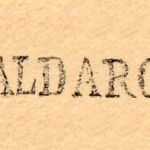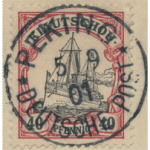Spud Papers – Zürich
 1843. 6 Rappen.
1843. 6 Rappen.
Of this stamp there are no fewer than six types, all very puzzling to the unlearned. These types differ from each other in the position of the lines forming the oblique black network, and in the size and spacing of the letters of ZURICH. The forgers have chosen Type II. for imitation. Until E. Fohl’s forgeries appeared upon the scene, a couple of years ago, there was not much difficulty in telling the genuine stamps, as there was no tréma (¨) over the u of ZURICH; but Mr Fohl kindly remedied this little mistake, and so deprived us of one sure test. I need not trouble our readers with the different types, though I have five of them before me as I write; but will simply show the differences which exist between the genuine stamps and the forgeries, choosing, as far as possible, only those features which are common to all types of the genuine.
Genuine
Lithographed in a greasy-looking black ink, on greyish-white paper. A number of faint pink lines cross the stamp below the impression; in some cases vertically, and in others horizontally. These lines are placed in a peculiar way—two and one—that is to say, first two lines close together, then one line a little apart, then two lines close together again, &c. This peculiarity in the burelé is a good test. The five square dots which form the cross in the left upper corner are quite distinct from each other. There are eight fine black lines running the top of the stamp, behind the word ZURICH, not counting the two thick lines above and below the word. In some copies the eighth line is very difficult to see, as it almost touches the thick line under ZURICH; but it is there nevertheless. There are also eight lines on the lower label, containing the words CANTONAL-TAXE, and these are easier to count than the others. The inner curl of the body of the 6 does not stop short when it reaches the inside of the curve, but runs down by the side of the upstroke halfway to the bottom again. This is another good test. The next test, which is a very trustworthy one, is rather difficult to explain without diagrams, but I will do my best to put it clearly. The groundwork of the stamp is formed by thin black lines, in sets of four, crossing each other obliquely. The arrangement of these lines differs in each of the types, but fortunately the forgeries do not agree with any type.
Postmarks
The usual postmark is a very pretty cross, somewhat like the cross-pattee on our black penny stamp, but rather more ornamented. It is struck in either red or black; the red being the commoner of the two.
Gum
The gum is brown, but most of the specimens I have seen have had the gum removed before coming into my hands.
Burelé
Our readers will please remember that besides the stamps with vertical and those with horizontal burelé, there are others which have no burelé at all. However, the other tests here given will be sufficient to ensure the detection of any forgeries which may exist without burelé, though all the forgeries which I have ever come across possess the burelé.
Forged
Lithographed in jet-black on very white paper. The burelé is composed of single lines, at equal distances apart. The five dots in the top left-hand corner almost always run into each other, forming a solid cross; and in the lightly-printed copies, where they do not happen to run together, they are too near the center of the little square which contains them. The dots touch the boundary lines of the square in the genuine stamps. The name-label contains only six fine horizontal lines inside the thick boundary lines. There are seven lines in the bottom label. The tail of the 6 stops short where it meets the body of the figure. For the groundwork, beginning to count from the right-hand top corner, the figures are 0. 16. 2. It will be seen that these figures do not agree with any type.
Besides the forgery just described, I have before me four others from Mr. Philbrick’s collection of forgeries, all different. The oblique lines of the groundwork in these forgeries are as follows:
- No. I: 2. 18. 2; 2.18.2.
- No. II: 3. 14. 1; 0. 15. 0.
- No. III: 0. 16. 3; 0. 16. 3.
- No. IV: 0. 16. 2; 2. 15. 2.
It will be observed that none of these forgeries correspond with any type of the genuine.
All Zurich stamps having 1843 in the angles, either one figure in each, or in any pair a combination, are false, and may be condemned at a glance.
Postmarks
Five thick parallel bars ornament the forgeries. I have never seen such a postmark on the genuine stamps.
Gum, etc. The forgeries are ungummed, and printed in sheets of 20, 4×5.
From “The Spud Papers” by Atless, Pemberton & Earée, 1871-1881.




Leave a Reply
Want to join the discussion?Feel free to contribute!